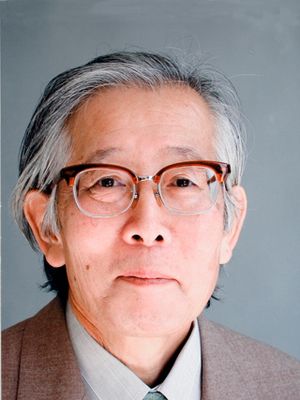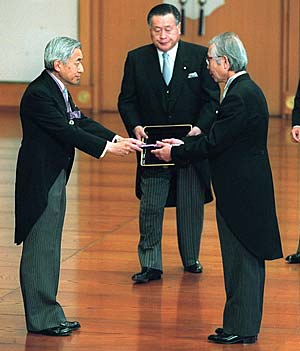Hideki Shirakawa facts for kids
Quick facts for kids
Hideki Shirakawa
|
|
|---|---|

Hideki Shirakawa in 2001
|
|
| Born | August 20, 1936 Tokyo, Japan
|
| Nationality | Japanese |
| Alma mater | Tokyo Institute of Technology (now Institute of Science Tokyo) |
| Known for | Conductive polymers |
| Awards | Nobel Prize in Chemistry (2000) Person of Cultural Merit (2000) Order of Culture (2000) |
| Scientific career | |
| Fields | Chemistry |
| Institutions | Tokyo Institute of Technology University of Pennsylvania University of Tsukuba |
Hideki Shirakawa (白川 英樹, Shirakawa Hideki, born August 20, 1936) is a Japanese chemist and engineer. He is a retired professor from the University of Tsukuba and Zhejiang University. He is famous for finding a way to make plastics that can conduct electricity. In 2000, he shared the Nobel Prize in Chemistry with Alan MacDiarmid and Alan Heeger for this amazing discovery.
Contents
Early Life and School

Hideki Shirakawa was born in Tokyo, Japan, on August 20, 1936. His father was a doctor for the military. Hideki had an older brother and a younger brother and sister. When he was a child, he lived in places like Manchukuo and Taiwan. Around third grade, his family moved to Takayama, Gifu, which was his mother's hometown.
He went to the Tokyo Institute of Technology. In 1961, he earned his bachelor's degree in chemical engineering. He continued his studies and received his doctorate in 1966. After finishing school, he became an assistant at the same university.
His Work and Discoveries
While working as an assistant in Japan, Dr. Shirakawa created a special plastic called polyacetylene. This plastic looked like metal. In 1975, a scientist named Alan MacDiarmid visited Tokyo Tech and was very interested in Shirakawa's work.
In 1976, Dr. Shirakawa was invited to work with Alan MacDiarmid at the University of Pennsylvania in the United States. There, they worked with another scientist, Alan Heeger. Together, they found out how to make polyacetylene conduct electricity.
In 1977, they made an important discovery. They found that adding a small amount of iodine vapor could make polyacetylene conduct electricity even better. This was a huge step! For their discovery of these "conductive polymers," the three scientists received the Nobel Prize in Chemistry in 2000.
In 1979, Dr. Shirakawa became a professor at the University of Tsukuba in Japan. He later became a full professor there.
What He Researched
Dr. Shirakawa's research focused on making plastics that could conduct electricity. He explored several key areas:
Making Polyacetylene Films
Polyacetylene was hard to work with because it didn't dissolve easily. Dr. Shirakawa found a way to make it into very thin films. These films helped him understand the structure of polyacetylene better.
Creating Metallic Conductivity
He discovered that adding a tiny bit of a chemical like bromine or iodine to polyacetylene films made them conduct electricity like metals. This happened because electrons could move between the added chemicals and the plastic.
Using Liquid Crystals for Polymerization
Dr. Shirakawa also found a new way to make highly conductive polyacetylene films. He used liquid crystals as a special kind of solvent during the process. He even managed to create spiral-shaped polyacetylene films.
What is Chirality?
Chirality is a property where a molecule is different from its mirror image. Think of your left and right hands; they are mirror images but cannot be perfectly placed on top of each other.
Making Liquid Crystalline Polymers
Dr. Shirakawa created special polymers that could arrange themselves in order. He could even use electric or magnetic fields to line up these molecules. This made the materials conduct electricity differently depending on the direction.
Awards and Honors
Dr. Shirakawa has received many important awards for his work:
- 1983 – The Award of the Society of Polymer Science, Japan
- 2000 – SPSJ Award for Outstanding Achievement in Polymer Science and Technology
- 2000 – Nobel Prize in Chemistry
- 2000 –
 Order of Culture and chosen as a Person of Cultural Merit
Order of Culture and chosen as a Person of Cultural Merit - 2000 – Professor Emeritus of the University of Tsukuba
- 2001 – Special Award of the Chemical Society of Japan
- 2001 – Member of the Japan Academy
- 2006 – Professor Emeritus of the Zhejiang University
The Nobel Prize
In 2000, Dr. Shirakawa won the Nobel Prize in Chemistry. He shared it with Alan J. Heeger and Alan MacDiarmid. They won for discovering and developing plastics that can conduct electricity. He was also the first Japanese Nobel winner who did not graduate from one of Japan's main national universities.
Dr. Shirakawa has often said that he hopes the media doesn't focus too much on the Nobel Prizes. He believes that many other important areas of science, not just those with Nobel categories, should also be recognized.
Public Views
On December 6, 2013, the Japanese parliament approved a new law about state secrets. Dr. Shirakawa and another Nobel winner, Toshihide Maskawa, spoke out against this law. They said it "threatens the peaceful principles and basic human rights" of the country. They believed it was important to protect freedom of the press, thought, and academic research.
See also
 In Spanish: Hideki Shirakawa para niños
In Spanish: Hideki Shirakawa para niños
- List of Japanese Nobel laureates


